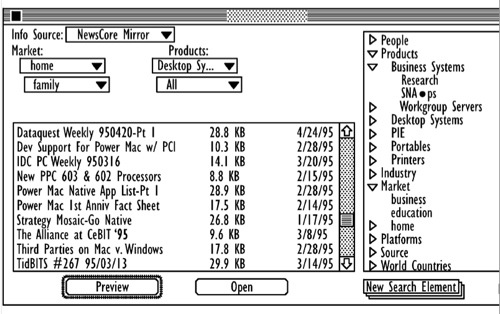According to Apple patent 2010040739 for a portable browsing interface for information retrieval the company is considering changes to Mac OS X that will beef up search features by combining the functionality of a full-text search engine with the flexibility of a browser.
The patent involves an integrated searching/browsing mechanism employs user-constructed information hierarchies that represent a cognitive framework for the organization of information. The hierarchies are independent of the information itself. This feature permits them to be shared among multiple users, and applied to any of a variety of different sources of information.
The hierarchical organization that is provided by the framework gives the user the ability to browse around any available document database in a manner that is intuitive to the user. Two or more hierarchies can be combined to locate documents which match the criteria of both hierarchies, and thereby refine search results to an appropriate level. A relevance feedback mechanism further enhances the browsing experience, by concentrating the search results in areas that are most relevant to documents selected as being of particular interest. The inventors are Richard Daniel Borovoy, Michael Graves, Michael Robert Hanson and Rao Nagabhushan.
Here’s Apple’s background and summary of the invention: “As greater amounts of information continue to be stored on, and accessed by, computerized information services, mechanisms which enable a user to locate and review information of interest become a critical component of an information retrieval system. Typically, one of two different types of mechanisms is employed by users to access documents that are relevant to their needs or interests. One such mechanism is the hierarchal browser, which permits the user to view groups of documents and identify the documents within the context in which they are stored.
“If a document of interest is located, related documents can be easily found as well, because the user is provided with the ability to look in areas surrounding the document of interest to see other documents that are stored with it. Hierarchal browsers are essentially one dimensional, in that a single tree-like structure is provided for navigating among documents. This mechanism may be acceptable for single-user systems, in which the user authored the hierarchy. However, in multi-user systems, such as news databases, help lines, work group databases, and the like, not all users may find the single hierarchy to be cognitively intuitive, and therefore may have difficulty navigating through the hierarchy to find documents of interest.
“The other type of retrieval mechanism, namely a full-text search engine, permits users to enter queries, and respond to those queries by returning document titles. These titles may be accompanied by relevance rankings or other indicators of the degree to which each document corresponds to the query. The document titles are typically presented to the user in the form of a list that may be sorted by relevance rankings, and do not provide any information regarding the context of the documents in the full database of information.
“Furthermore, they do not give the user the ability to browse through the spaces that are occupied by the listed documents, to locate related documents which were not selected as a result of the query. Such systems tend to work best for users who are looking for specific information, and they require a certain level of skill in constructing appropriate queries, since the results are highly dependent upon the terms which the user employs as an expression of interest.
“It is an objective of the present invention to provide a document retrieval mechanism that offers the functionality of a full-text search engine, to enable a user to readily identify documents meeting that user’s criteria, while at the same time offering the flexibility of a browser, to permit the user to locate related documents that may not match a specific query but which may nevertheless be of interest to the user.
“In accordance with the foregoing objective, the present invention provides an integrated searching/browsing mechanism that enables users to construct information hierarchies that represent a cognitive framework for the organization of information, and to apply those hierarchies to any database of information. With this approach, the user is provided with the ability to navigate any available document database in a manner that is intuitive to that user. Furthermore, a user can combine two or more hierarchies to locate documents which match the criteria of both hierarchies, to further refine the collection of documents that are presented to the user. A significant feature of this approach is that the hierarchies can be constructed and applied independently of any particular document collection.
“The information retrieval system of the invention is comprised of three main components. Dimension files represent information hierarchies constructed by users. A search and indexing system indexes information and returns lists of documents in accordance with the hierarchal structure defined in the dimension files. A user interface enables the user to specify the information to be retrieved, and provides the user with the ability to browse through various hierarchal levels of information. A system comprised of these components can be applied to a variety of different sources of information.
“The system of the present invention enables users to view any collection of documents via a cognitive framework, as represented by browser hierarchies, which is useful, meaningful and comfortable to the users. It also permits the users to switch from one browser hierarchy to another, or to combine hierarchies in a single browsing experience. As a result, the user is able to browse over independent document collections, rather than being required to perform targeted searches that may limit the information presented to the user.”
— Dennis Sellers
dsellers@applecentral.com

